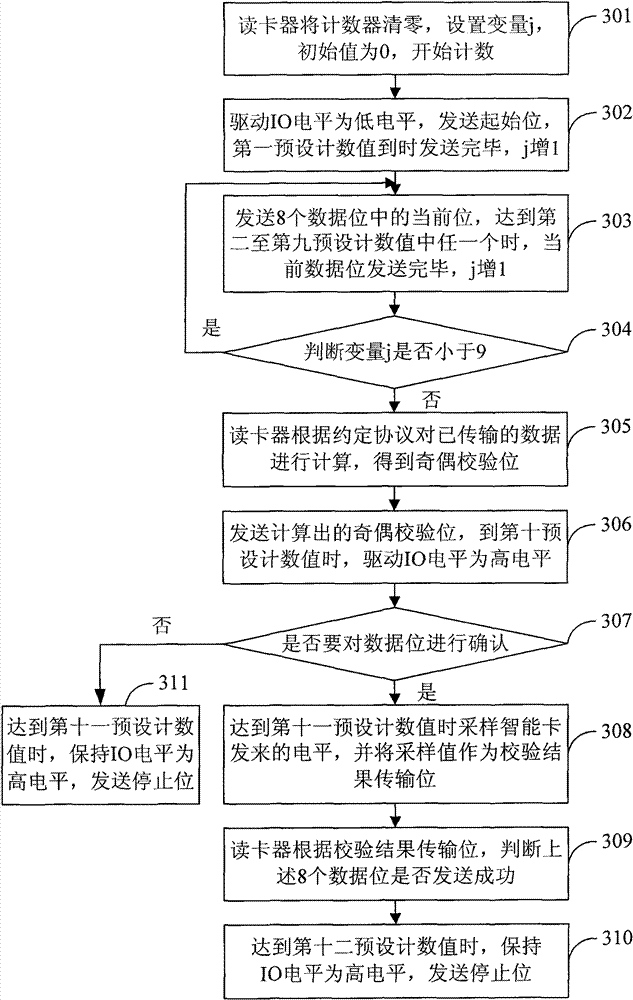Timing sequence control method and card reader
A timing controller and timing control technology, applied in the field of smart cards, can solve the problems of variable timing, complicated IC card reader firmware program design, and increased calculation amount, so as to reduce the complexity and communication bit error rate, and achieve good results. The effect of portability and precise timing control
- Summary
- Abstract
- Description
- Claims
- Application Information
AI Technical Summary
Problems solved by technology
Method used
Image
Examples
Embodiment 1
[0053] see image 3 , this embodiment provides a method for implementing timing control by counting with a counter, which is used in an application scenario where a card reader sends data to a smart card when communicating with the smart card.
[0054] In this embodiment, the timing is controlled by counting with a counter. Specifically, the counter uses the CLK signal of the smart card as a clock source, keeps synchronous with the working clock of the smart card, and counts according to the clock source.
[0055] In this example, the preset clock rate conversion factor is 372, and the baud rate adjustment factor is 1, then the duration of each bit is 372 clock cycles, that is, when the count value of the counter reaches 372 clock cycles or 372 When it is an integer multiple of the clock cycle, it is considered that the current transmission of one bit is completed. Moreover, the count value of the counter is set in advance according to the clock rate conversion factor 372 and...
Embodiment 2
[0086] see Figure 4 , this embodiment provides a method for implementing timing control by means of a timer, which is used in an application scenario in which a card reader sends data to a smart card when communicating with the smart card.
[0087] In this embodiment, the timing is controlled by a timer. Specifically, the timer uses the CLK signal of the smart card as a clock source, keeps synchronous with the working clock of the smart card, and performs timing according to the clock source.
[0088] In this example, the pre-set clock rate conversion factor is 372, the baud rate adjustment factor is 1, then the duration of each bit is 372 clock cycles, and the pre-set clock frequency of the smart card is 4MHz, so when the timer When the timing value reaches 93 microseconds, it is considered that the timing transmission of a bit is currently completed, and the receiving and sending of data is controlled according to the timing value of the preset timer. In actual implementati...
Embodiment 3
[0117] see Figure 5 , this embodiment provides a card reader, specifically including:
[0118] Timing control module 501, used for controlling the timing when the card reader sends data to the smart card;
[0119]The sending module 502 is used to drive the IO level to a low level, convert the first bit into a level and send it out. When the timing control module reaches the first preset control value, the card reader sends the data word to be sent section, and convert the data bytes to be sent into the second bit to the ninth bit, and convert the second bit to the ninth bit into levels and send them out in sequence according to the agreed protocol. In the timing control module Sequentially reach the second preset control value, the third preset control value, the fourth preset control value, the fifth preset control value, the sixth preset control value, the seventh preset control value, and the eighth preset control value and the ninth preset control value, complete the tr...
PUM
 Login to View More
Login to View More Abstract
Description
Claims
Application Information
 Login to View More
Login to View More - R&D
- Intellectual Property
- Life Sciences
- Materials
- Tech Scout
- Unparalleled Data Quality
- Higher Quality Content
- 60% Fewer Hallucinations
Browse by: Latest US Patents, China's latest patents, Technical Efficacy Thesaurus, Application Domain, Technology Topic, Popular Technical Reports.
© 2025 PatSnap. All rights reserved.Legal|Privacy policy|Modern Slavery Act Transparency Statement|Sitemap|About US| Contact US: help@patsnap.com



